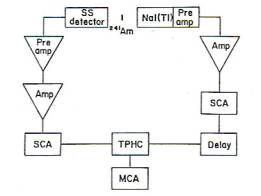

We have been working on an experiment to measure the lifetime of the 60keV state in 237Np which is populated in the alpha decay of 241Am. So far we have been working on energy calibrations in order to find the channel number for the 60keV state of 241Am. We will eventually use the delayed coincidence method using a time-to-pulse-height converter (TPHC). This device converts a time period between two logic pulses into an output pulse whose height is proportional to this duration. The time measurement is triggered by a START pulse and halted by a STOP signal. A simple method for this is to begin a constant discharge of a capacitator at the arrival of a START signal and to cut off the discharge when the STOP appears. The total charge collected will be proportional to the time difference between the START and STOP signals.
We will be using Am for this experiment because it is relatively cheap and has a very long half-life (458 years). Also, the 237Np lifetime measurement involves the detection of a 5.5 MeV α particle in coincidence with a 60keV gamma ray. This allows the lab to be completed in a three hour lab period. Finally, with a 67 nanosecond lifetime for the 60keV state in 241Np the electronics do not have to be quite so sophisticated to obtain the final time resolution (electronics diagram below). For the 60keV gamma ray to be prominent among the gamma ray spectrum, many of the transitions in 237Np occur by emission of internal conversion electrons. The source has a small spot of radioactive material electrodeposited onto a 2.5 centimeter-diameter flat disc of stainless steel. A special holder is needed so the source can be inserted from one side and a solid-state particle detector from the other within 0.5 centimeter of the source. The entire assembly is then taped to the front of a 7.6 X 7.6 cm NaI(TI) detector assembly.
| This diagram shows the decay scheme of 241Am | This is a block diagram of the electronics for the experiment | |
 |
 |